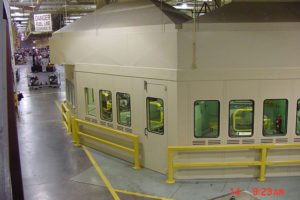Industrial Noise Control Engineering
Industrial Noise Control Engineering
IES-2000 has been assisting clients resolve their industrial noise control and noise level issues with acoustical engineering for over 20 years, whether it is providing compliance with new equipment specifications pertaining to industrial noise levels, feasibility studies, workplace noise exposure monitoring, industrial noise reduction and community noise studies. The scope of the work is developed by the client to determine how to attain their goals of meeting or exceeding regulatory or company standards pertaining to acceptable industrial noise levels, employee exposures or community noise issues.
Feasibility Study Objectives
- Determine a Design Goal
- Determine the Existing Acoustical Condition
- Determine the Required Industrial Noise Reduction
- Identify the Sound Transmission Paths
- Design Potential Noise Abatement Systems
- Final Report
Workplace Noise Exposure Objectives
- Noise Exposure Monitoring performed per OSHA regulations
- Identify employees for inclusion in hearing conservation program and allow for proper selection of hearing protection based on noise exposure.
- Identify specific areas for investigation of engineering or administrative noise control strategies.
- Provide annual reviews of noise exposure.
- Presentation of noise exposure report and database.
Community Noise Studies Objectives
- Determine what, if any, noise ordinances are in place that the client.
- Determine the existing industrial noise levels around the facility as well as the adjacent areas of concern.
- Identify the noise sources prompting the complaints from the adjacent neighborhoods.
- Recommend noise control and abatement measures to the noise sources identified and predict resulting noise levels upon implementation of abatement measures.
Our Work

Automotive Transfer Press Line
A large automotive manufacturer wants to reduce the industrial noise level from their press line 1 A to below 85 dBA for the job function Time Weighted Average (TWA). Press line 1A consists of 4 transfer presses in sequence stamping a variety of automotive parts. As you can imagine, each press requires access to load dies. Access to the line between each press is different.

Automotive Engine Test Cell
Another automotive manufacturer needed to reduce the background noise around and engine test cell. Access to the area at multiple points and ventilation were critical to the success of this project. The noise level inside the enclosure was reduced to 45 dBA.

Glass Furnace
Reduce the noise below an 85 dBA job function TWA for the operators of a large glass furnace. To reduce cost of both the enclosure and the installation, metal panels were used for industrial noise reduction at the ground level for durability and curtains were used above the metal panels to reduce noise but also reduce cost.

Test Chamber
Provide an area on the manufacturing floor where assemblies can be quickly checked for industrial noise levels. To do this, the background noise must be reduced from 85 dBA to 40 dBA inside the unit, again, while providing easy access.